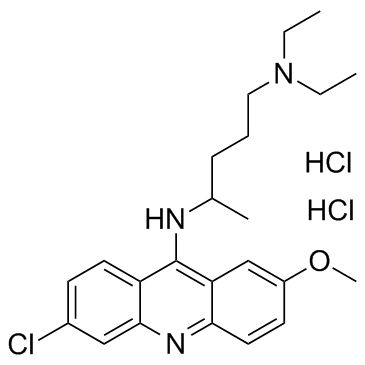Quinacrine dihydrochloride (Mepacrine dihydrochloride) |
| Catalog No.GC32768 |
Products are for research use only. Not for human use. We do not sell to patients.

Cas No.: 1969/5/6
Sample solution is provided at 25 µL, 10mM.
Quinacrine is a fluorescent probe for the conformational transitions of the cholinergic receptor protein. Quinacrine shows activity in the low μM range with a mean IC50 of 2.30 μM In the patient AML cells.IC50 value: 2.30 μM (for AML cells)Target:in vitro: Quinacrine is a fluorescent probe for the conformational transitions of the cholinergic receptor protein in its membrane-bound state.[1] In the patient AML samples, Quinacrine showed activity in the low μM range with a mean IC50 of 2.30 μM, statistically significantly lower than that of normal PBMCs; 3.54 μM (P=0.0327; Student's t-test). Samples from patients with chronic lymphocytic, acute myeloid and lymphocytic leukemias as well as peripheral blood mononuclear cells (PBMC) were tested in response to 1266 compounds from the LOPAC1280 library. 25 compounds were defined as hits with activity in all leukemia subgroups (<50% cell survival compared with control) at 10 μM drug concentration. Only Quinacrine showed concurrent high activity in all leukemia subgroups and low activity in normal PBMCs and was, therefore, selected for further preclinical evaluation. Quinacrine also induced early inhibition of both DNA and protein synthesis. Quinacrine have repositioning potential for treatment of acute myeloid leukemia by targeting of ribosomal biogenesis.[2]
[1]. Grünhagen HH, et al. Studies on the electrogenic action of acetylcholine with Torpedo marmorata electric organ. IV. Quinacrine: a fluorescent probe for the conformational transitions of the cholinergic receptor protein in its membrane-bound state. J Mol Biol. 1976 Sep 25;106(3):497-516. [2]. Eriksson A, et al. Drug screen in patient cells suggests quinacrine to be repositioned for treatment of acute myeloid leukemia.Blood Cancer J. 2015 Apr 17;5:e307.
Average Rating: 5 (Based on Reviews and 34 reference(s) in Google Scholar.)
GLPBIO products are for RESEARCH USE ONLY. Please make sure your review or question is research based.
Required fields are marked with *




















